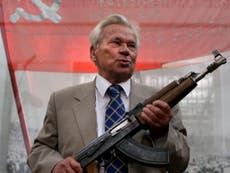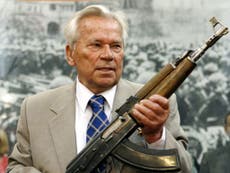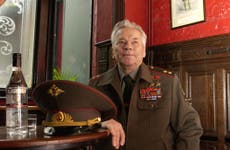Analysis: World at war is good news for Kalashnikov and its new gun
Diplomatic Channels: The return to animosity between Moscow and Nato has been good for Russian arms manufacturer

Mikhail Kalashnikov had mixed feelings about designing the world’s most famous assault rifle. Asked whether he regretted producing a weapon that may have caused more deaths than any other in the past half-century, his stock answer was: “I invented it for the protection of the Motherland. I have no regrets and bear no responsibility for how politicians use it.”
Nearer death, however, he was to reflect: “I am sad that it is used by terrorists. I would prefer to have invented a machine that people like farmers could use, like a lawnmower.” But demand for the eponymous gun, however, shows no sign of dwindling. The manufacturers will this week announce doubling production over the next three years from 150,000 to 300,000, launching a rebranding campaign and upgrading the successors of the AK-47 to a new AK-12.
The expansion comes despite the company, Kalashnikov Concern, being among Russian arms manufacturers put on a sanctions list over the Kremlin’s annexation of Crimea and its role in eastern Ukraine.
But, with conflicts around the world showing no signs of abating, and, with new ones, such as Barack Obama’s “war on Isis” now firmly under way, there are no shortages of customers. The Russian armed forces have declined to take up the AK-12 because they have a surfeit of older AK-74s, but a concerted effort will be made to change their mind. President Vladimir Putin has ordered a £290bn overhaul of the armed forces: it was announced that Russian scientists are working to restart the running of nuclear missile trains, seen until now as a relic of the Cold War.
The return to animosity between Moscow and Nato has been good for Russian arms manufacturers, with the Kremlin appearing to decide that, with international sanctions, more efforts and investment must be made on internal productions. The decision by the French government to delay the delivery of two Mistral helicopter-carriers until further notice has further reinforced that view.
Senior Sgt Mikhail Timofeevich Kalashnikov, who had never finished school, designed his rifle when Russia, France, the US and Britain were facing a common enemy. The work began after repeated complaints by fellow soldiers of being outgunned by the invading Germans.
The Kalashnikov became a favourite prop in photographs for terrorist leaders and dictators, Osama bin Laden and Saddam Hussein liked to be photographed holding one. But they have also been of immense value in wars of liberation against colonial powers. Cheap to produce, they can be assembled by someone with no military training. And they do not normally jam, partly because of the simplicity of the moving parts, or seize up – however severe the weather.
The rifles have also become a fashion statement. I was offered gold-plated Kalashnikovs at a hotel in Baghdad 14 years ago; a few of them appeared in Darfur at an auction four years later; the smiling Sudanese hotel doorman had turned up there as a leader of one of the rebel factions.
More unexpectedly, I saw gold-plated ones on sale as designer table lamps in, of all places, an uber-trendy department store in liberal Copenhagen last month for the equivalent of £800 each. One wonders what Kalashnikov, the a holder of the Stalin Prize First Class, three Orders of Lenin and the Hero of Socialist Labour title, would have made of that.




Join our commenting forum
Join thought-provoking conversations, follow other Independent readers and see their replies